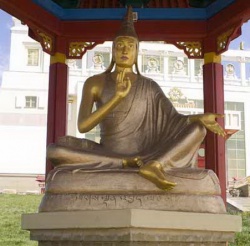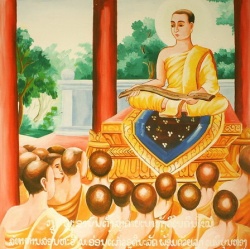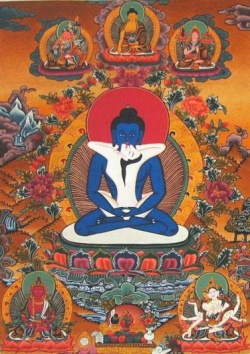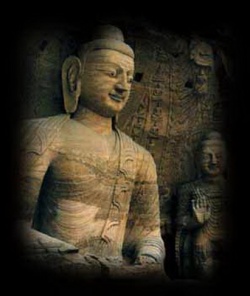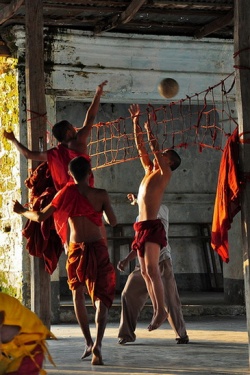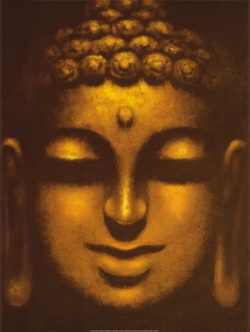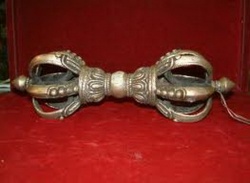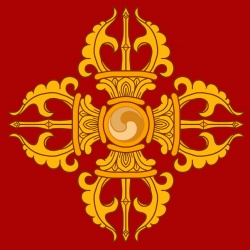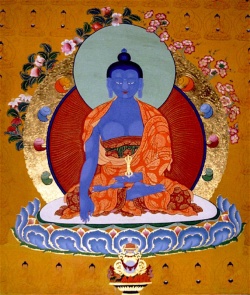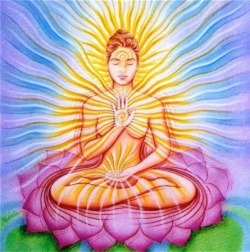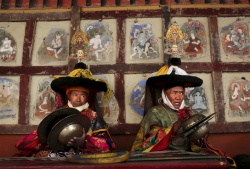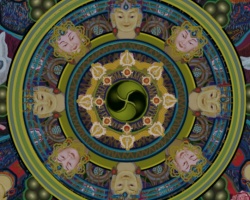The Profound Meaning of Buddhist Ceremonies: Offerings to ''The Triple Gems''
Following the article in our August issue, which covered a total of 49 different worship offerings to monks, this month we would like to discuss some of the different worship offerings to the "Triple Gems" (defined above) as follows :-
Thoob -- (Incense or Joss sticks) : 4,000 years ago, the Aryans, descendants of the prehistoric people who spoke Indo-European, invaded the land of the Dravidians who lived in the northern subcontinent of present-day India. The Aryans adopted some of the traits of the Dravidians, but relegated the people to a second class rank in the caste system. During the following centuries the Aryan culture, represented by more than a dozen tribal republics, spread slowly to the Ganges and then further south. By 500 B.C., the Singhalese, an Aryan people, had reached Sri Lanka.
The distinctive religion of the Aryans was a cluster of beliefs that became known as Hinduism. (During those ancient days the Persians who came to have contacts with them called the Aryans "Hindu people" and their beliefs "Hinduism" due to the Persians mispronunciation of the name of the Sindhu River as the Hindu or Indus River.) The Hindu beliefs ranged from notions about animal spirits to complex philosophical doctrines. Central ideas included purification from worldliness, the idea of reincarnation, and the concept of the underlying Brahman, or absolute self. In religious terms, Hinduism and Brahmanism are the same. Hindu beliefs are recorded in the Veda, the most ancient sacred literature of Hinduism, or individual books belonging to that literature. This body of ancient literature consists primarily of four collections of Hymnals, detached poetical portions, and ceremonial formulas. The collections are called the Rig-Veda, the Sama-Veda, the Yajur-Veda and the Atharva-Veda. They are known also as the Samhitas (roughly "collection").
The first three Samhitas are primarily ritual handbooks that were used in the Vedic period by three classes of priests who officiated at ceremonial sacrifices. The Rig-Veda contains more than 1000 hymns (Sanskrit rig), composed in various poetic meters and arranged in ten books. It was used by the hotri, or reciters, who invoked the gods by reading its hymns aloud. The Sama-Veda contains verse portions taken mainly from the Rig-Veda. It was used by the udgatri, or chanters, who sang its hymns, or melodies (Sanskrit sama). The Yajur-Veda, which now consists of two recensions, both of them partly in prose and partly in verse and both containing roughly the same material (although differently arranged), contains sacrificial formulae (Sanskrit yaja, "sacrifices"). It was used by the adhvaryu, priests who recited appropriate formulae from the Yajur-Veda while actually performing the sacrificial actions.
The fourth Veda, the Atharva-Veda (in part attributed by tradition to a rishi named Atharvan), consists almost exclusively of a wide variety of hymns, magical incantations, and magical spells. Largely for personal, domestic use, it was not originally accepted as authoritative because of the deviant nature of its contents. Scholars believe that it dates from a later time and that it may have been derived mainly from the remnant of the indigenous pre-Aryan culture. Eventually it was acknowledged as one of the Vedas, especially after its adoption as a ritual handbook by the Brahmans, the fourth and highest class of priests officiating at the sacrifices.
Supplementary to the Brahmanas are later esoteric works known as forest treatises, the Aranyakas from Sanskrit aranya, "forest." The Aranyakas were expounded and written by Brahman sages in forests because it was felt that a proper understanding of them could be achieved only in seclusion. The final portions of the Aranyakas are called Upanishads. Profound metaphysical and speculative works closely linked with the Brahmanas, they emphasize knowledge and meditation and are the first Hindu attempts at a systematic treatment of speculative thought. Vedanta and most other Indian philosophical systems developed from the Upanishads.
During the Vedic Period, people's ancient belief of Animism was slowly changed to Polytheism and Henotheism respectively. And during the Brahman Period, intellectuals applied Monotheism and Monism to their beliefs. These theories reached to the Epic Period which produced the two epic sagas -- Ramayana and Maha Bharata.
The latest products of the Vedic period were the sutras (Sanskrit Sutra, literally "thread," roughly, "string of rules"). Collections of aphorisms elaborating and dissertating on the Vedic sacrifices, domestic ceremonies (such as marriage and funeral rituals), and religious and secular law, the sutras are significant for their influence on the development of Hindu law. As works of authority, they are not as highly regarded as the Vedas, Brahmanas, and Upanishads. The latter, especially the Vedas, are revered as apaurusheya (Sanskrit, "not of human origin").
The faith of Brahmanism / Hinduism is like a tree that has grown for 3,500 years --- Vedic Period (1,500-600 BC), Epic Period (600 BC), and Hinduism Period (AD 167). All of these beliefs were related. Their followers devoted their time along with their beliefs for sacrifices, hymns, magical incantations, yogas, offerings, ceremonies, etc. Incense is believed to have been a part of these ceremonial events. Solid storax resin was spread over a hearth or torch, India's sweet-scented aromatic fragrance was produced by slow burning. Sandal wood and mansonia were also used for these purposes. This kind of fragrance has been regarded as the smell of peace. It is the nature of human beings who like to not only solve problems but to develop new things as well. Therefore, people started to make joss-sticks by using a powder of storax, sandalwood, or mansonia glued on sticks with a natural adhesive -- resin. As mentioned earlier Brahmanism and Hinduism long preceded Buddhism, and incense and other items were easily adopted into various Buddhist ceremonies, as Buddhism is purely a philosophy for believers to help them deal with problems and to attain happiness.
Whenever a joss-stick is burned during worship, the monks and Buddhist followers gain a feeling of respect in their minds, ... of cleansing through their eyes, if there is no excessive smoke from the many joss-sticks, and... of peace through the environment of silence. Joss-sticks are also regarded as a symbol of paying homage to Lord Buddha. 3 joss-sticks must be presented each time, each with its own symbolism. The first stands for Lord Buddha's wisdom, the second for his purity, and the third for his kindness.
After chanting and making their wishes, worshippers bend low to plant 3 joss-sticks in a clay container or ceramic vase containing sand or dry clay. This vase must be located in the centre at a level lower than the Buddha image.
Thien -- (Candle) : Beeswax or tallow are the sources of raw wax, which, along with embedded wicks, are used for candle production. The candles were regarded as not only the source of domestic light but also of Dhamma or Buddhist doctrine. It is the duty of Buddhist followers to present a giant candle as a worship offering to their community temple before the start of the three-month Buddhist lent, called Khao Pansa. This giant candle must be alight 24 hours a day throughout the whole lenten season. Smaller candles would also be offered for domestic use inside the monks' residence. A ceremonial parade would proceed from a selected place of significance to the community's temple. Apart from the giant lenten candles mentioned above, a pair of candles of average size are always used in Buddhist ceremonies, as well as for daily private worship at home. The two candles are lit and placed on the candle sticks or holders at the front right and front-left sides of the Buddha image.
Dawk-Mhai -- (Flowers)
Dawk-Bua -- (Lotus) is regarded as one of the symbols of Buddhism. The purity, morality, and cleanliness of lotus signifies an insight of knowledge, while mud and mire symbolize the lives of human beings. Lord Buddha's doctrine or wisdom which contains purity and knowledge is likened to the lotus blossoming above the water's surface, while the lotus stem and root are deep in mud and mire, where it is hoped that Dhamma may reach human beings with their many problems. There is an analogy, along with a particular Dhamma, that a good person, an average person, and a bad person can be likened to a lotus bloom above the water's surface, it's stem in water, and it's roots in mud and mire respectively. For each ceremony or daily practice at home, a single lotus in an erect vase or flat dish can be placed in front of the Buddha image.
Lotus, a symbol of Lord Buddha's favorite flower, reminds us of Buddhism, purity and cleanliness, and the virtues of loving-kindness, friendliness, compassion, merit, goodness, unity, and pureness of heart.
Dawk-Mhai Mongkol -- (Auspicious Flowers) : Buddhist followers always place a pair of vases at the front right and left of the altar set of a Buddha image. The size of the vase depends on the kind of ceremony, where it takes place, and whether it is public or private worship. Along with an offering of joss-sticks and candles, the major varieties of auspicious flowers are: Philippines violet , Flame of the forest Dolichan- drone crispa , Mollotus , Annatto Burmania Dendrobium , Orchids, Jasmine, Collinsae Chinese Ixora , Marigold and others used less often. The factors influencing availability include the season, and the growing environment.
Khaan -- (Tray) : A round wooden, lacquerware, or ceramic tray is used to bear incense or jogs-sticks, candles and flowers as worship offerings to the Triple Gems The shape of the tray can sometimes be square or rectangular The tray itself is quite shallow. Various types of trays are described here:
Khaan Gaew Taang Saam -- (Grand Tray) : Grand tray Following ceremonial worship, a community elder would lead others, carrying jogs-sticks, candles, and flowers, in giving these as offerings placed on the Khaan Gaew. This kind of collection shows the unity of the people in that community. The size of this grand wooden tray is about 18-20" in diameter and 30" in height. The tray itself is often beautifully carved or painted. The design on the surface may be covered with gold or silver foil, in a style called "Rod Naam" in Thai, meaning "washed with water". The final stage of this kind of decoration involves washing the object to remove any unwanted gold foil, leaving the beautiful gilded design standing out. Some temples may have 3 Khaan Gaew used to separately bear jogs-sticks, candles, or flowers giving an appearance of order and neatness. The number of these trays depends on the generosity of contributions made by community and temple leaders.
Khaan Hah Gotaak -- (Grand Tray of 5 collections) : gotaak For worship offerings, three separate collections, called Gotaak, paid homage to the Triple Gems. Two additional Gotaak pay homage to parents and teachers, and to meditating monks. The 5 institutions together may be regarded as "Quintuple Gems."
Khaan Toke Pra-Jao -- (Buddha's Khaan Toke) : toke luangA "Khaan Toke" is a round tray which serves as a small low table on which to put food. This tray was traditionally made from a single solid piece of teakwood, lathed and carved. These old Khaan Toke trays, after lathing, carving and sanding to smoothness, were then coated with natural polymers. Bamboo and rattan are also used in the construction of Khaan Toke Trays, and lacquered using the same process as that for making lacquerware. Bamboo Khaan Toke Trays are quite popular. The size of Khaan Toke Trays differs according to its intended use at dinners or ceremonies. The largest, the Grand Khaan Toke Tray, is called the "Khaan Toke Luang" with a diameter that may range from 25 to 50 inches. These 'Grand' Trays have traditionally been used in palaces and temples in the North. Five typical dishes are served at a Khaan Toke Dinner, along with a large bowl of steamed rice and a straw basket of sticky rice. The dishes are: "Gai Tawd", pieces of succulent fried chicken; steamed or fried vegetables, or "Pudt Pugg", usually with cabbage predominating; Burmese Pork Curry, or "Gaeng Hung-Lay", a mild or slightly spicy dish consisting of large chunks of roasted or barbecued pork; medium spicy tomato chill) paste, or "Nahm Prik Ong", served with fresh cucumber slices for dipping; and a dessert of semi-sweet popped rice crackers, along with coffee or tea.
When Buddhist believers carry food and sweetmeats to a temple as worship offerings, all the foods are collected and separated into groups. Later all the Khaan Toke sets will be offered to all monks, reserving a mini-set or Khaan Toke Pra-Jao to be placed before the Buddha image.
Khaan Num Taan -- (Heavy-Duty Tray) : Num Taan Whenever Buddhist believers wants to make a worship offering to a Buddha image or monk, they must consider: (a) Whether the offering is light enough to lift, (b) The distance between the offer and the image or monk is correct, (c) The offerer must sit and bend forward in the humble gesture of great respect called "Prakane", (d) After the monk accepts the offer, the offerer may not touch it again, (e) If the offering is heavy, the ceremony cannot take place unless a Khaan Num Taang is used. This is an opportunity for a large group to participate, especially when Buddhist followers come to the temple together with worship offerings, i e. joss sticks, candles, a variety of flowers, and with or without food and sweetmeats. A large tray must be used to bear the first three important items. The size of this tray is about 10-15" high and 10-15"wide. Along auspicious thread is needed to connect the offerers' hands to the Khaan Num Taang and to the monk's hands. The entire offering will be divided into 2 equal parts for proper wishes -- (1 ) Merit, and (2) Auspicious Happiness.
Khaan Khor Seelp -- (Addressing Tray) : Khor Seelp At the start of ceremonial chantings performed by a small group of monks, Buddhist believers must follow the tradition of addressing using a Khaan Khor Seelp. This is a communication between the group leader and the most senior monk. Before addressing the monk, the group leader must "Prakane" his Khaan Khor Seelp on which are flowers, candles and jogs-sticks. Each of these offerings may be attached together in units of nine, three or five. (9 stands for "progress", 3 for the "Triple Gems ", and 5 for the "Five Basic Precepts"). The size of the Khaan Khor Seelp is about 15" high and 15" wide, with a 2-3" thick rim. The purposes for having a Khaan Khor Seelp are... (a) Collecting all offerings together demonstrates discipline and order, (b) It shows the unity of the community, (c) It is a good example of tradition, (d) It helps teach discipline, (e) To pay respect to monks, (f) It is correct practice for devoted Buddhist believers.
Khaan Suma -- (Tray of Apology) : This is a tray of 3 sections. Each section bears 3 offerings -- joss-stick, candle and flower. Each section represents an offending act through touch, words or unkind thoughts. A wrongdoer would carry this Khaan Suma and go to pay respect to the senior person he or she had offended through any of those acts.
Khaan Bucha (Phee) Suea Wat -- (Tray offering to the Temple Spirit) : This is of Brahman or Hindu influence. People believe, along with Buddhism that "Suea Wat" is a care-taking spirit, giving peace to the whole temple grounds. It is a tradition for some temples to arrange a large tray for local citizens to make offerings of 2 joss-sticks, food, and a glass of water.
Khaan Nimon -- (Tray of Respectful Invitation) : Some temples still provide this to local Buddhist followers who would like to invite the senior monk to perform a ceremony inside the temple. The typical ceremonial offerings are flowers, joss-sticks and candles.
Khaan Tung -- (Teacher Salutation Tray): The world Taang means "setting up" in preparation for a ceremonial performance. It should be called "Paan Kru"-- a tray of salutation to teachers. A ceremony must be held before an activity begins. These might include the building of a new temple, a monk's residence, a house, a coffin or many other things. The following 12 items must be placed on the Khaan Tung: (1) 12 cones of popped rice and flowers, (2) 16 betel nuts, (3) 16 folded leaves of the betel vine, (4) 16 joss sticks, (5) 16 candles, (6) 16 cowrie shells, (7) 1 folded white cloth, (8) 2 folded red cloths, (9) 16 Baht coins, (10) 1 bottle of rice whisky, (11) 1 tray of paddy rice, (12) 1 tray of milled rice.
Khaan Kru -- (Small tray for Teacher Salutation) : This is a smaller version of Khaan Tung. The Khaan Kru must have (1) 6 individual flowers, (2) 6 candles, (3) 6 joss-sticks, (4) 6 pieces of popped rice, (5) cash in to the sum of 6 Baht or more... up to 1,300 Baht.
Khaan Maak -- (Betel Nut Tray) : The expression Paan Maak comes from the central region. There are 3 main chewing snacks served on the tray -- betel palm nut, betel pepper vine leaves and red lime. These small Khaan Maak can be made of bamboo, rattan, wood, lacquerware, brass, silver or gold. The design and materials used would depend on the owners' status.
Khaan Miang -- (Tea Tray) : Miang is the Lanna word for pickled tea while the word Shaa (green or black tea) comes from the central region. The majority of Thai people drink tea as the Chinese do, infusing dry tea leaves in hot water. Lanna people have a different style of preparing and consuming Miang. They pick young tea leaves, wrap them together, insert them in a jar and steam until cooked. They are then fermented for 5-6 months in woven bamboo containers until the leaves are pickled. Consumers will add some salt and put it in the mouth after each meal. The Miang maybe chewed and sucked from 30 minutes to one hour. A cigarette may be smoked at the same time. This handy Kaan Miang is a typical small personal tray.
Kome --(Lanterns)
Kome Kwaen or Kome Khaang -- (Hanging Lantern) are also offered to pay respect or pray to "The Triple Gems". This lantern may be in a variety of shapes. These are the Baat Pra (Alms bowl), Dow (Star), Ta Gra (Basket), and Tammajak (the wheel of law which means to have thorough knowledge about religious discourses). Buddhists will hang these lanterns around a temple, vihara, alms-house, sala, or house.
Kome Paad -- (Rotating Lantern) is an interesting lantern because it revolves on an axis. This is done with the aid of a lighted candle placed inside the lantern where little gadgets convert the energy from the flame to make it revolve. The lantern is globe-shaped, like planet Earth. Usually it is decorated with pictures such as the 12 characters of the horoscope. This revolving lantern gives the effect of shadow puppets. It is placed at the temple gates and may not be moved from one place to another.
Kome Thuea or Kome Hu Gratai -- (Rabbit's Ear Lantern) has a lighted candle inside. Worshippers take these lanterns and decorate the temples, vihara, and other buildings. If there are celebrations, these beautifully made lanterns are used to decorate the stage. Usually, this is a lantern shaped as a lotus blossom with long tails hanging below (looking like a rabbit's ear), and is used to pay respect and when worshippers pray to the Triple Gems or make offerings to the monks.
Kome Taang -- is a standard standing lantern which can be placed on the floor, table, or altar. There are different shapes with all kinds of beautiful decoration.
Standing or Holding Type of Decorative Symbols
Satta Bhand -- (Grand Candelabrum) : Every temple in Northern Thailand must have at least one Satta Bhand. Some temples may have several pieces. There are 4 purposes behind the creation of these beautiful ornaments -- (1) Respectful worship offering to The Triple Gems, (2) Merit making for auspicious happiness, (3) To preserve Buddhist heritage, (4) To preserve the fine arts of engraving and carving.
From a Buddhist perspective, the Satta Bhand indicates 7 enlightenment factors -- (1) Mindfulness, (2) Truth - investigation (3) Effort or energy, (4) Zest, (5) Tranquility or calmness, (6) Concentration, (7) Equanimity. Therefore, whenever Buddhist believers light candles on the Satta Bhand, they must think of these 7 factors that lead to becoming a good Buddhist.
This fine art form is based on the Hindu - Buddhist cosmological story --- Shiva's palace is in heaven, located on the top of Mount Meru, which is itself surrounded by 7 other mountains. Shiva's rival tried to create a problem by stirring up the whole ocean's waters of the oceans, using many Naga (Naak) coiling and uncoiling. This great turbulence shook even the mountains. Eventually the Nagas became very tired and Shiva's rival attacked and punished them. In retaliation the Nagas spat venom over the ocean, and the sea water became poisonous. Shiva then had to suck out all poison of the Nagas. The people thus created Satta Bhand as a worship offering object to Shiva who had provided happiness to them.
Khundai-Gaew -- (Jewel Ladder)
Khundai-Come -- (Gold Ladder)
Khundai-Ngern -- (Silver Ladder)
This worship offering is a finely and beautifully engraved and carved candelabrum crafted by two ethnic groups known as Tai Lue and Tai Yong. The design on the surface is covered with colorful glass (symbolizing jewelled steps) combined with alternate gold and silver foil (symbolizing gold and silver steps). This unique article is based on the meditative experience of Lord Buddha's visit to his mother who passed away when he was 7 days old.
She dwelt in Indra's heaven when the Buddha visited her. He ascended to heaven and seated himself on a throne under the coral tree of paradise. There he delivered a sermon on the Abhidamma Pitaka to Sri Mahamaya Devi and Lord Sakka. Thousands of devas (angels) gathered during the three months of sermons.
Tung Thian -- (Candelabrum) : This piece is simple and cheap, and is very useful especially at smaller up-country temples. Local citizens use a steel or iron frame with tin or zinc sheet that has been cut or welded according to the design of 3 different ladders similar to the beautiful piece mentioned in (6.2). The 3 different groups stand for "The Triple Gems". Each stepped group could be 2 meters long with guttering below to collect melted candle wax, preventing any damage to the floor, altar, table, or carpet.
Thai Temple Murals When visitors to Thailand go to see some of the country's finer old temples, they may be puzzled at the artistic conventions of the murals which cover much of the wall space. The flat, two-dimensional style of the figures and the almost complete lack of perspective in the rendering may be foreign to the viewers' concept of Asian art.
These temple murals are as much a part of the religious composition of the temple as is the principal Buddha image on the main altar. Lay people of the temple donate money to the temple to pay for the painting of one of the murals as an act of making Buddhist merit. The artist who received the commission was circumscribed by ritual and belief. When painting scenes from the life of the Buddha the artist needed to confirm this was an act of religious devotion rather than emulating holy events or usurping creation.
Stylistic conventions evolved over time in Thai history dictated where scenes from the life of the Buddha, scenes from the Jatakas folk tales which narrate events from the Buddha's previous lives to illustrate his teachings, depictions of heavenly beings, and scenes from the lives of ordinary human beings might be painted. The flat style of how the figures and scenes are painted were also dictated by the way in which temple walls were prepared for the mural, the brushes and pigment sources of the artists, and art styles which influenced the earliest muralists.
The Thai muralist had to deal with the problem of early deterioration of mural paintings on the temple walls. In Thailand the soil from which the bricks in the wall are made had a high saline content, which would have quickly destroyed his work. The wall was first repeatedly washed with lime water in which the pounded leaves of a leguminous tree and fine sand had been added, and was allowed to dry thoroughly after each application. When tested and found to be salt-free, the wall was given a final washing, allowed to dry, and then gesso was applied. The gesso which backed the mural was made from chalk with a vegetable binder and was applied in several thin coats, each carefully smoothed. A primer, usually red or black, was applied before the figural painting began, which gives the murals their monochrome aspect.
The basic pigments were riverbed clays and ocher, which provided the red color painted as a preliminary outline of figures in the mural, minerals, and plants were sources for greens and black color from soot. These were pounded fine in a mortar and pestle and mixed with a tree gum binder. For special decoration, strips of gold leaf were applied to the mural, glued on with a kind of tree gum.
The artists' brushes were made from different kinds of roots and bark which provided brushes intended for specific pictorial detail. The sinuous, fine line evident in temple murals is a result of the nature of these brushes.
The arrangement of figures and scenes depicted in temple murals varies greatly. For the side walls of the building, however, a general rule of thumb would be that the highest row of figures are beings who have the greatest degree of spiritual development, and depictions below them are lesser developed beings in sequential order ending with humans.
At the top of murals are depictions of thepchumnum (Thepshoomnoom); heavenly beings, which replaced earlier depictions of the Buddha. Below these there might be illustrations of scenes from the life of the Buddha, such as the defeat of mara(marn), where the Buddha is shown attaining enlightenment in meditation while the demons of temptation are kept at bay. Below these there might be scenes from the Jatakas, and lower down scenes of everyday life or scenes from the Thai version of the Ramayana.
The area behind the main altar might be painted with portrayals of the Traiphum(Traipoom), the three regions of Buddhist cosmology, namely heaven, earth, and hell. The lowest portions of this would show humans suffering for their sins in the Buddhist version of hell.
In painting the murals, the main figures were first outlined and then filled in, with the wealth of decorative detail between the figures added last.
Visitors to Chiang Mai can view a particularly fine example of temple mural painting in the main wiharn of the wat Pra Singh. A wealth of detail about life at the time of the mural's painting can be seen with royal figures clothed in typical style and the common people in Burmese fashion of the period.
When visiting temples in Thailand, make sure to take note of the intricate detail and subtle beauty of Thai temple murals
